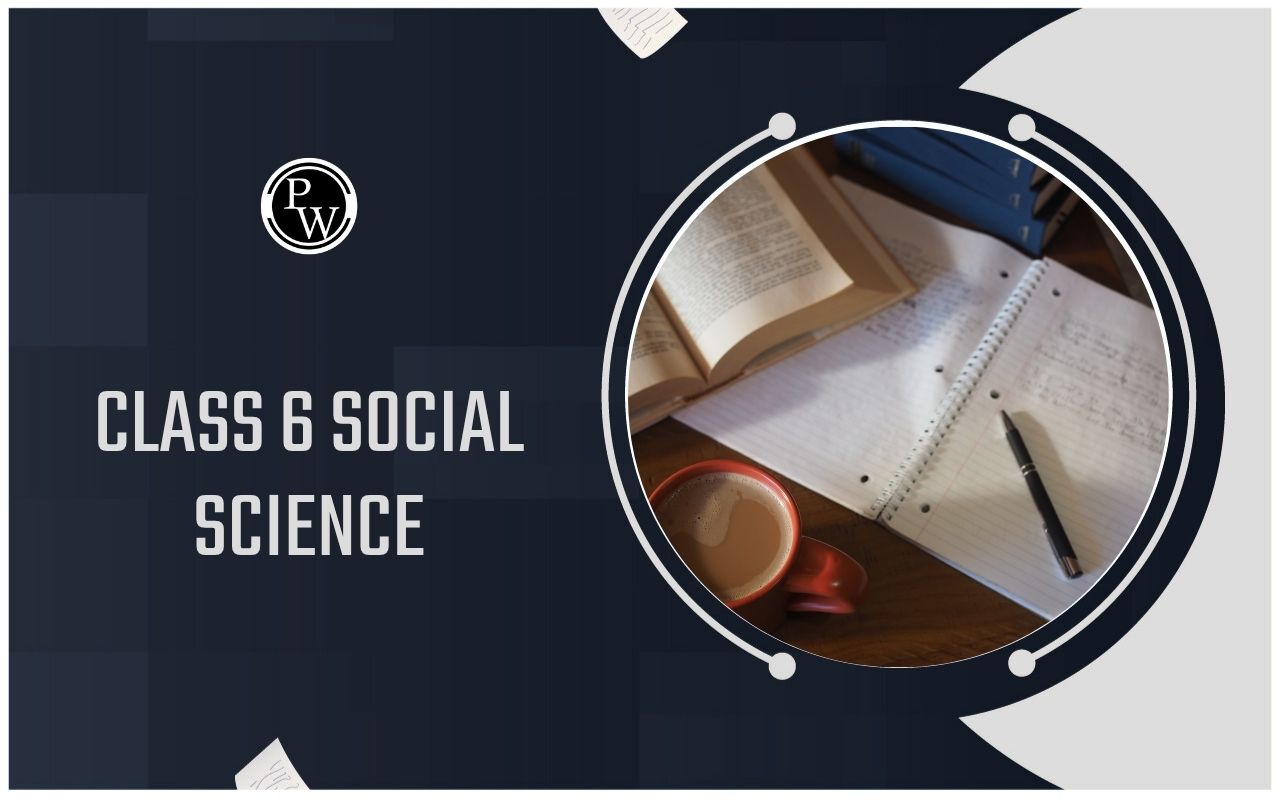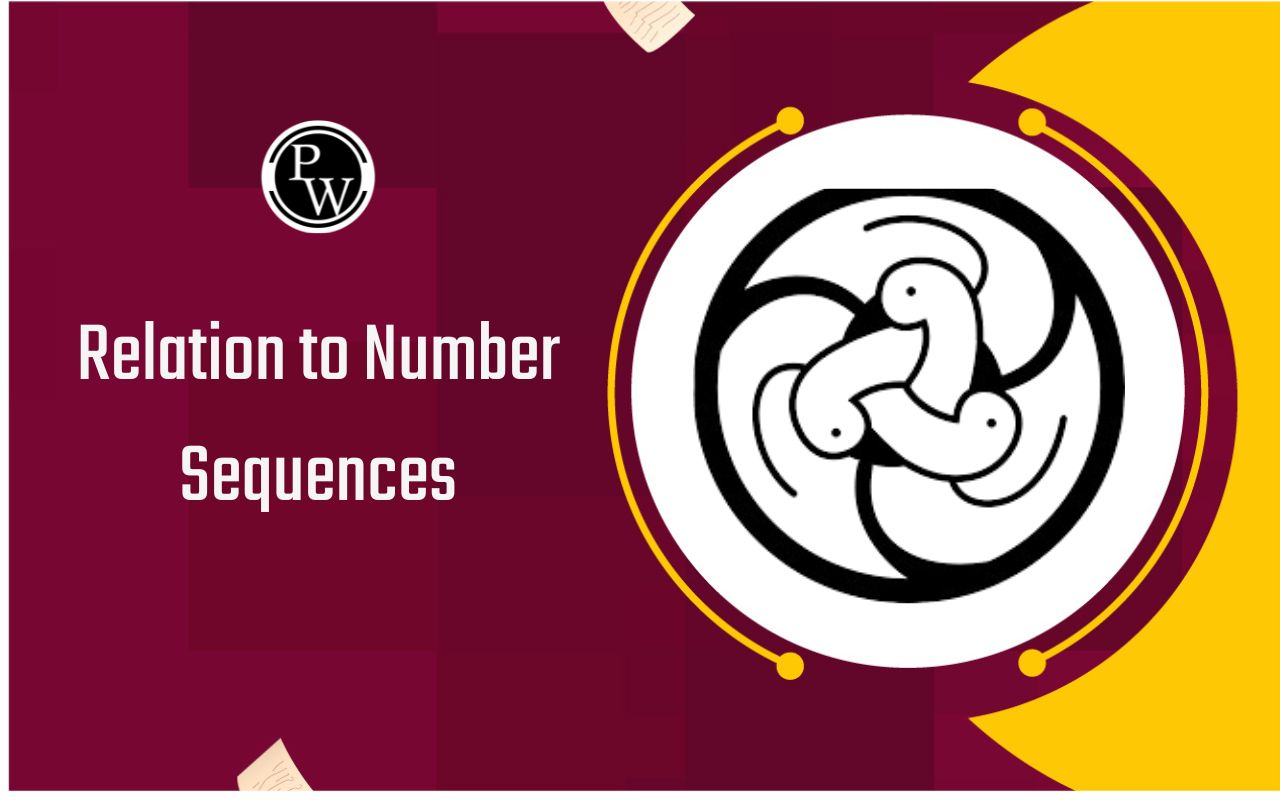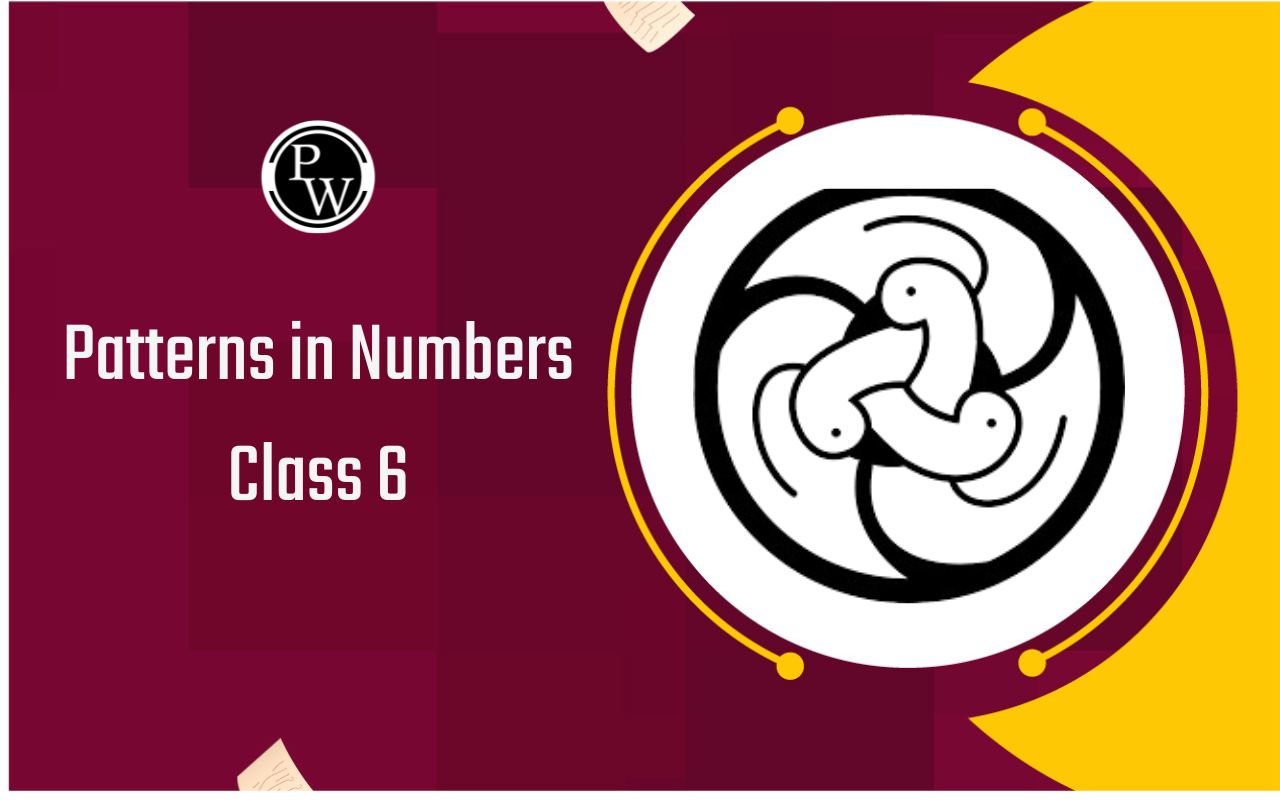
NCERT Solutions for Class 6 Maths Chapter 13
NCERT Solutions For Class 6 Maths Chapter 13: NCERT Solutions for Class 6 Maths Chapter 13 on Symmetry offer valuable help for CBSE students preparing for their final exams. The solutions provided follow a step-by-step approach to solving textbook questions, taking into account the marks allocated as per the CBSE Board exam pattern. These solutions are beneficial for students to recognize and address weak concepts, leading to better scores. Additionally, they contribute to enhancing students' time management skills, crucial for success in exams.NCERT Solutions for Class 6 Maths Chapter 13 PDF Download
NCERT Solutions for Class 6 Maths Chapter 13 Symmetry
Symmetry refers to a balanced and proportional similarity observed in two halves of an object. In simpler terms, one part of the figure reflects the other, like a mirror image. The Line of Symmetry is an imaginary line where folding the figure results in symmetrical halves. This chapter systematically explains various symmetry-related concepts. Keep reading for detailed NCERT Solutions for Class 6 Chapter 12 Symmetry: Exercise 13.1 Page No. 263 1. List any four symmetrical objects from your home or school. Solutions: The four symmetrical objects are the blackboard, tabletop, pair of scissors, and computer disc. 2. For the given figure, which one is the mirror line, l 1 or l 2 ?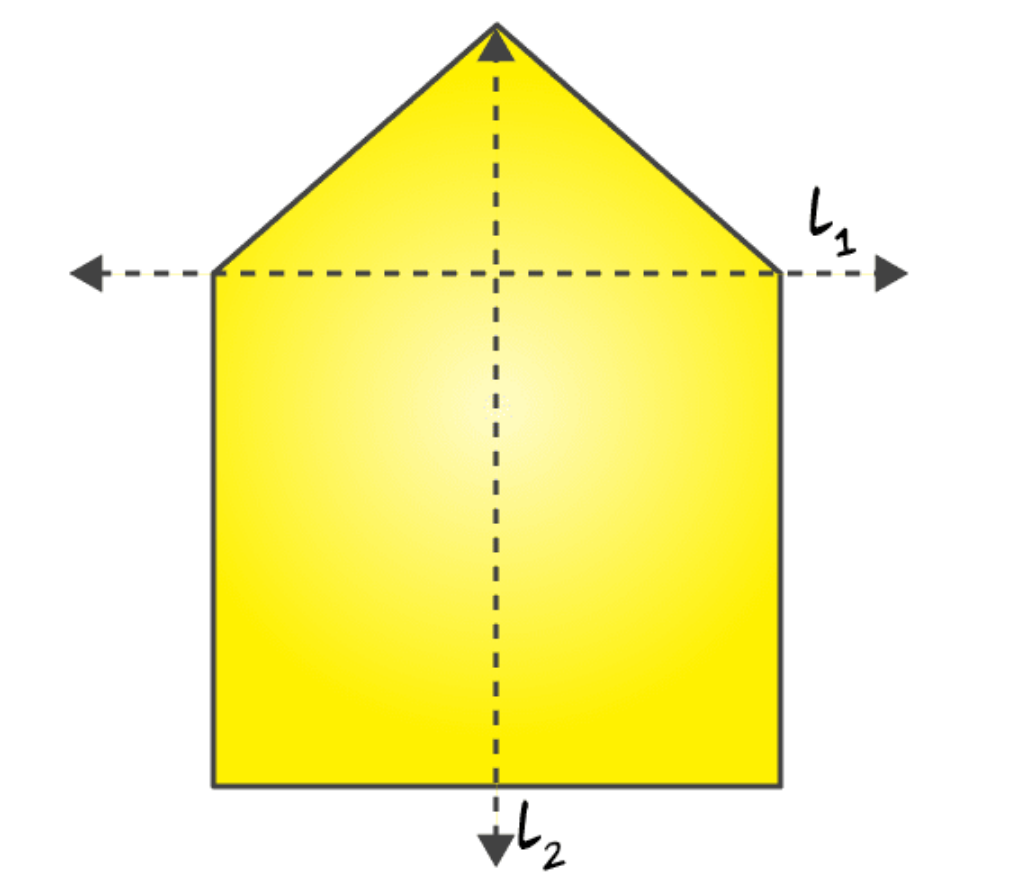 Solutions:
l
2
is the mirror line of the figure. When the given figure is folded about the line l
2,
the left part exactly covers the right part and vice versa.
3. Identify the shapes given below. Check whether they are symmetric or not. Draw the line of symmetry as well.
Solutions:
l
2
is the mirror line of the figure. When the given figure is folded about the line l
2,
the left part exactly covers the right part and vice versa.
3. Identify the shapes given below. Check whether they are symmetric or not. Draw the line of symmetry as well.
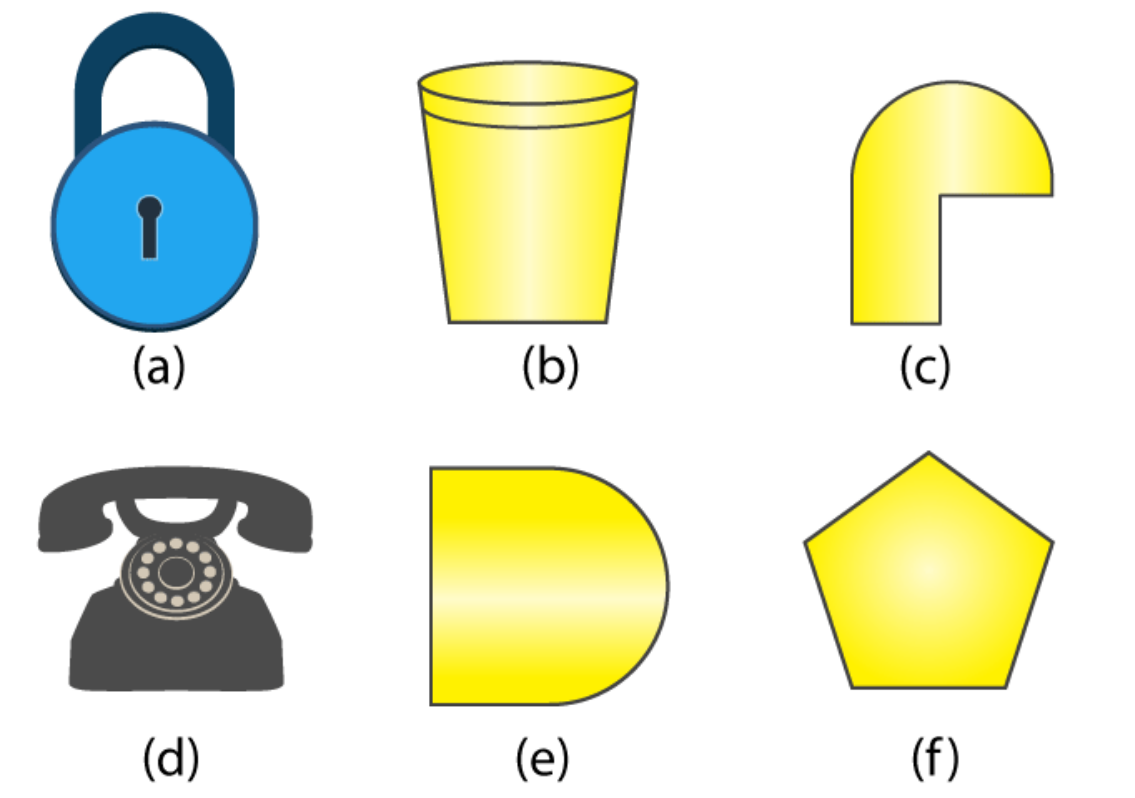 Solutions:
(a)
Yes, it is symmetric
(b)
Yes, it is symmetric
(c)
No, it is not symmetric
(d)
Yes, it is symmetric
(e)
Yes, it is symmetric
(f)
Yes, it is symmetric
The figures given below are the line of symmetry:
Solutions:
(a)
Yes, it is symmetric
(b)
Yes, it is symmetric
(c)
No, it is not symmetric
(d)
Yes, it is symmetric
(e)
Yes, it is symmetric
(f)
Yes, it is symmetric
The figures given below are the line of symmetry:
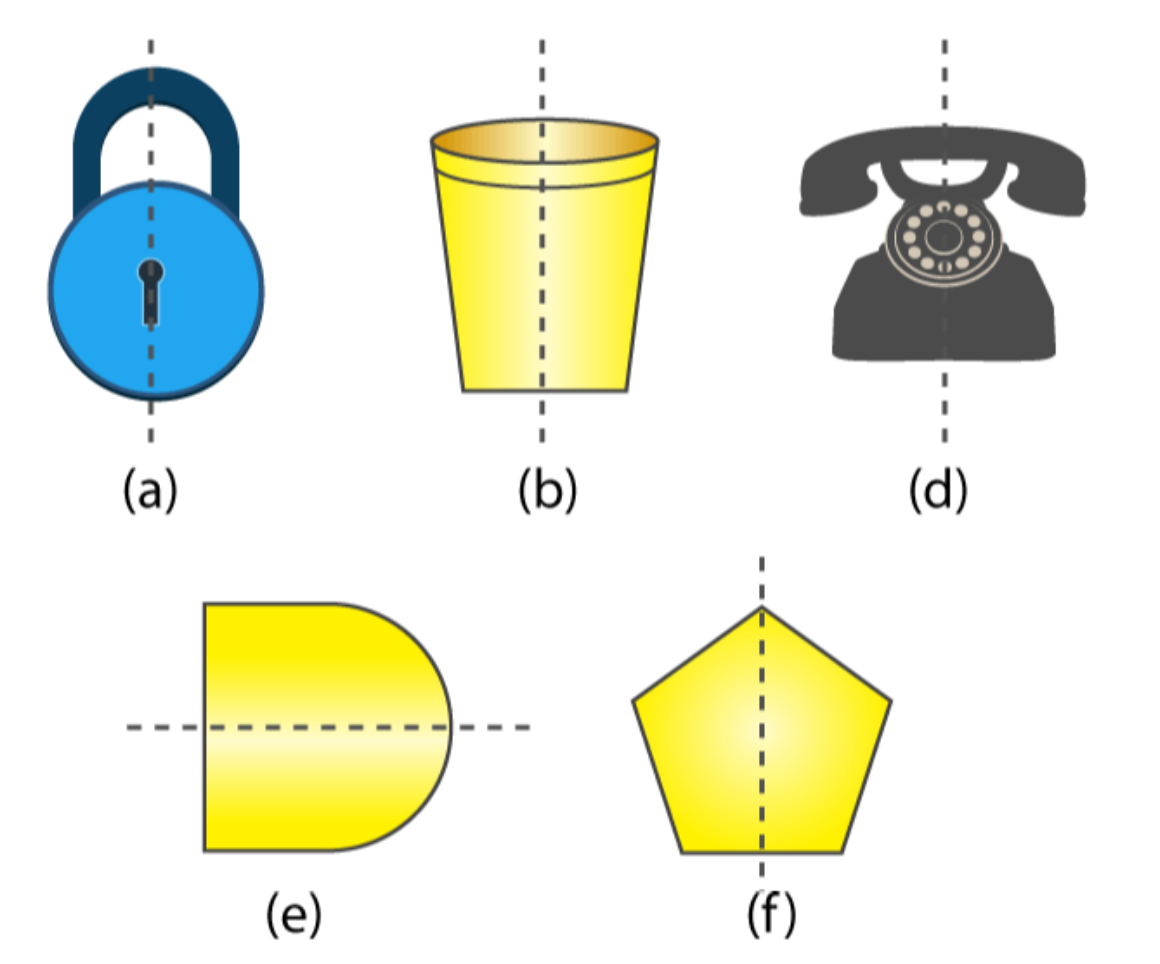 4. Copy the following on a square paper (The square paper is what you would have used in your arithmetic notebook in earlier classes). Then, complete them such that the dotted line is the line of symmetry.
4. Copy the following on a square paper (The square paper is what you would have used in your arithmetic notebook in earlier classes). Then, complete them such that the dotted line is the line of symmetry.
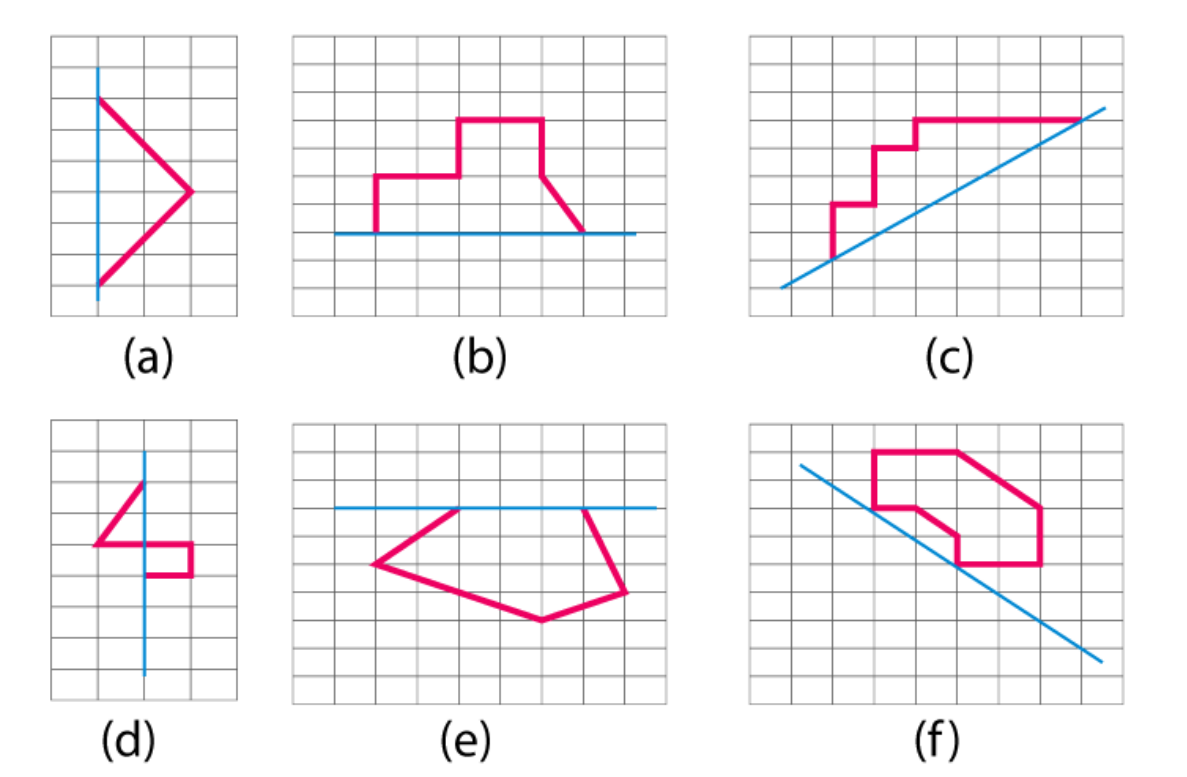 Solutions:
To make the dotted line as a line of symmetry, the given figure may be drawn as follows:
Solutions:
To make the dotted line as a line of symmetry, the given figure may be drawn as follows:
(a)
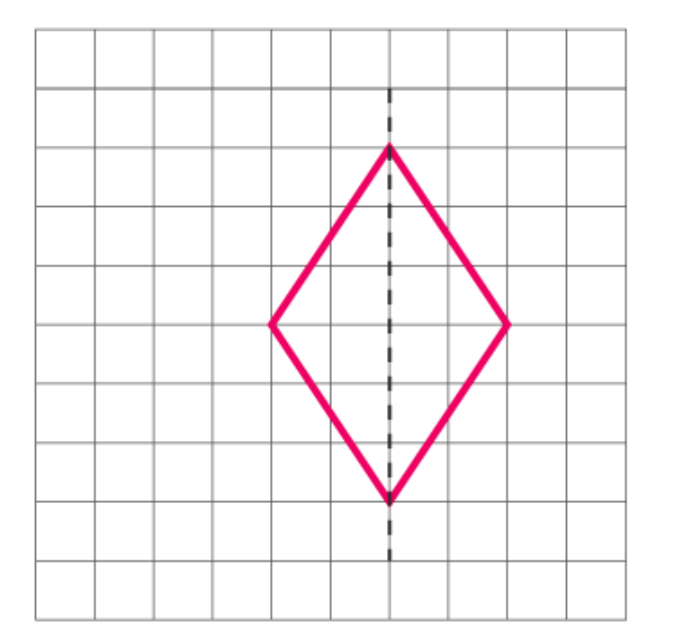
(b)
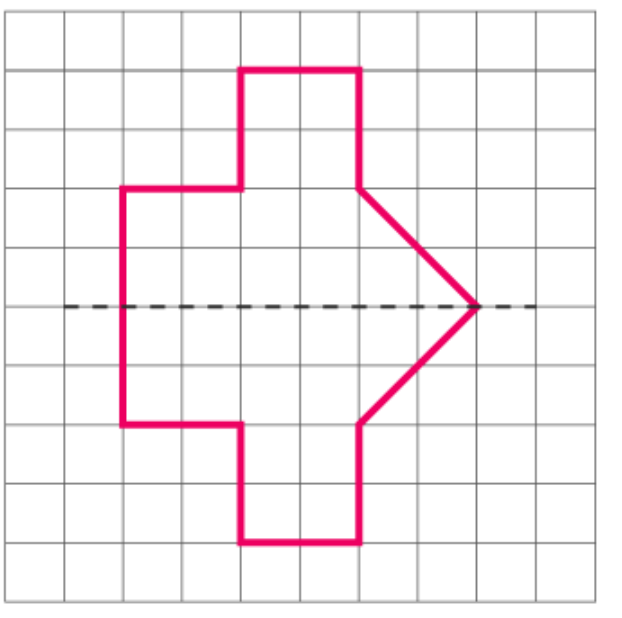
(c)
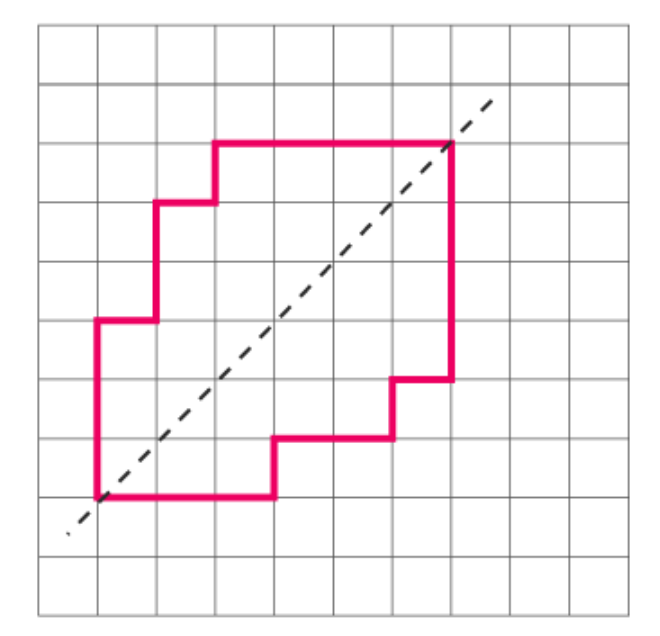
(d)
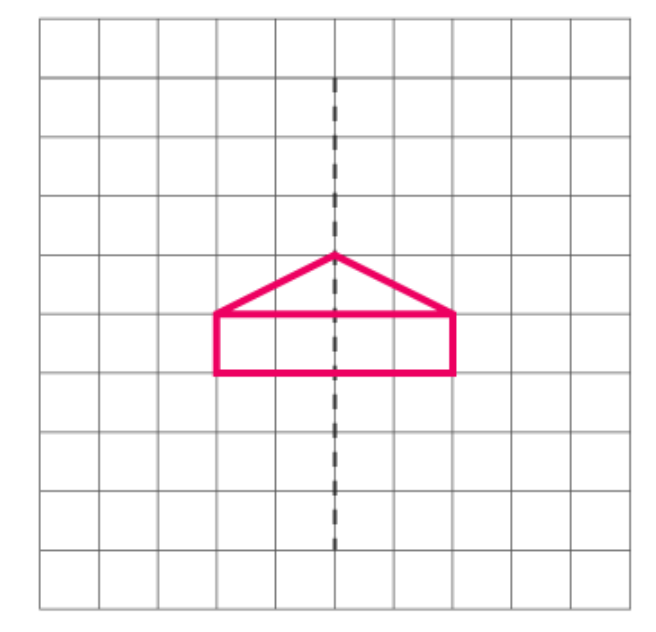
(e)
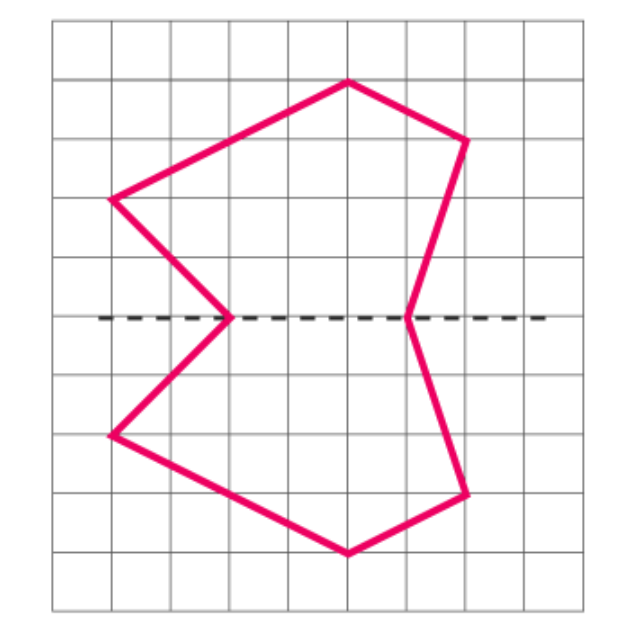
(f)
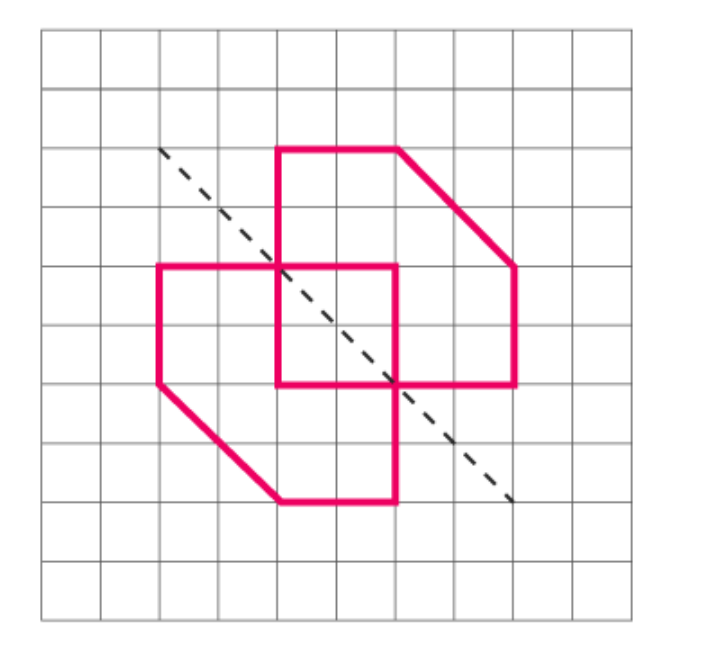 5. In the figure, l is the line of symmetry. Complete the diagram to make it symmetric.
5. In the figure, l is the line of symmetry. Complete the diagram to make it symmetric.
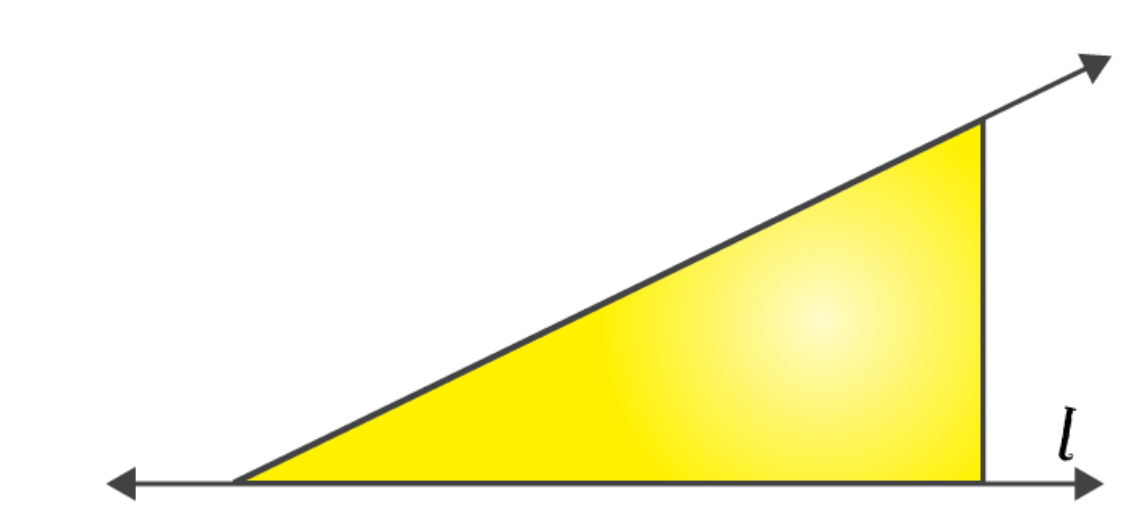 Solutions:
The below figure is the exact diagram to make it symmetric:
Solutions:
The below figure is the exact diagram to make it symmetric:
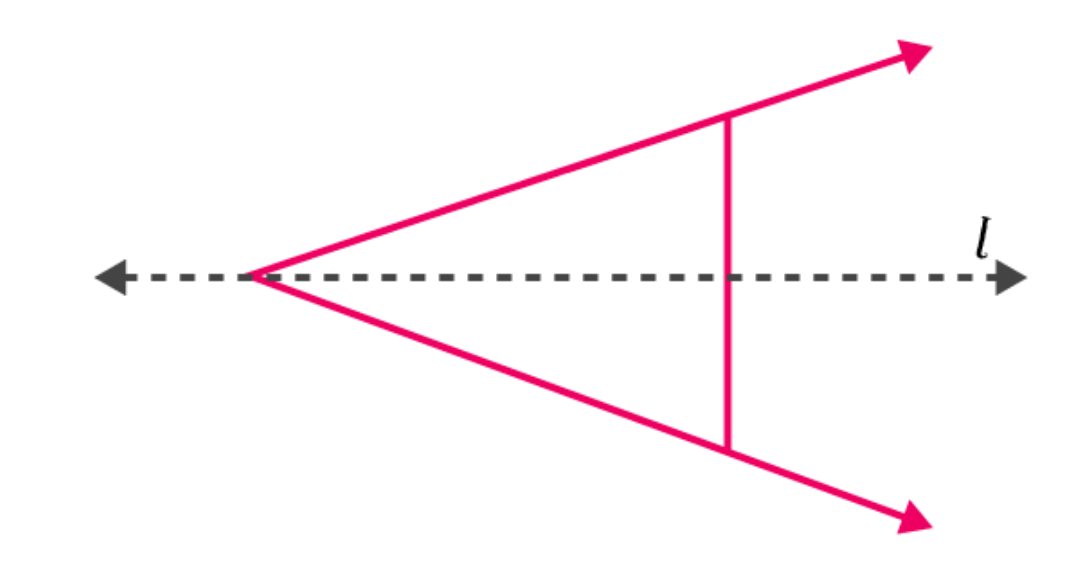 6. In the figure, l is the line of symmetry. Draw the image of the triangle and complete the diagram so that it becomes symmetric.
6. In the figure, l is the line of symmetry. Draw the image of the triangle and complete the diagram so that it becomes symmetric.
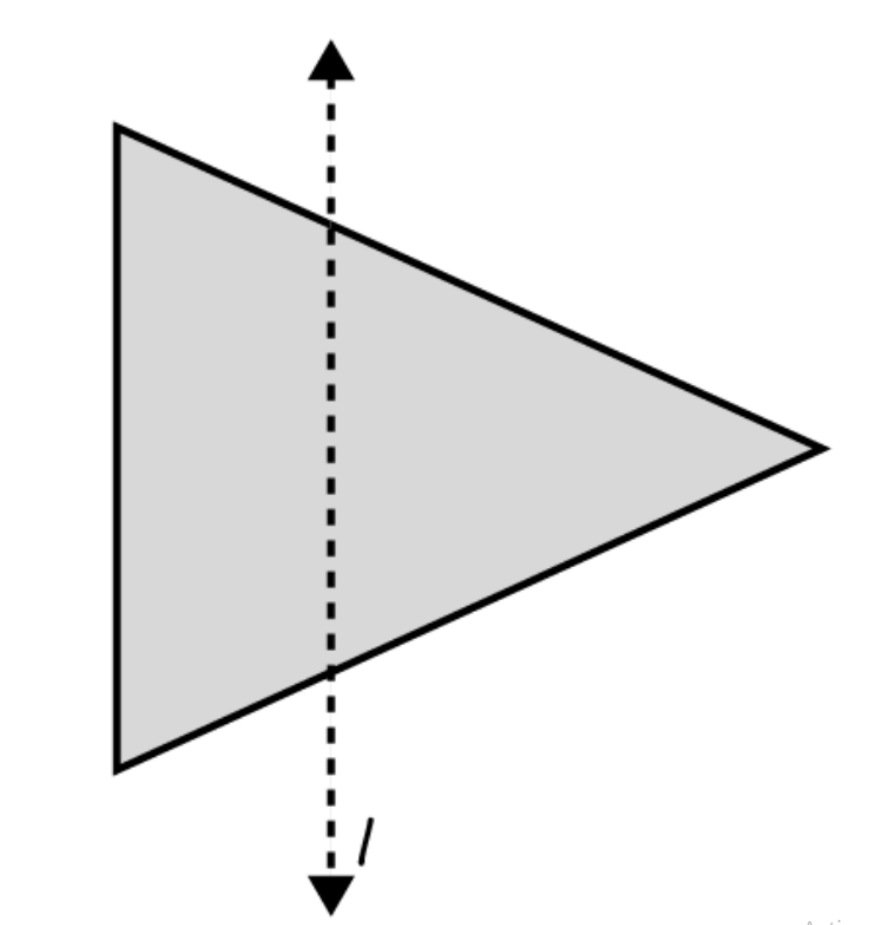 Solutions:
The required triangle can be drawn as follows to make it symmetric:
Solutions:
The required triangle can be drawn as follows to make it symmetric:
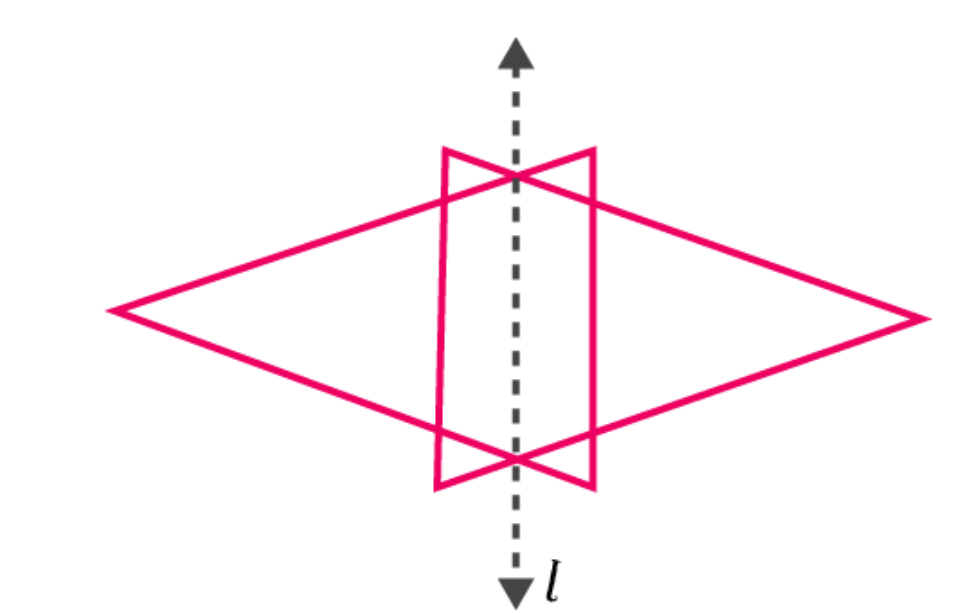 Exercise 13.2 Page No. 267
1. Find the number of lines of symmetry for each of the following shapes :
Exercise 13.2 Page No. 267
1. Find the number of lines of symmetry for each of the following shapes :
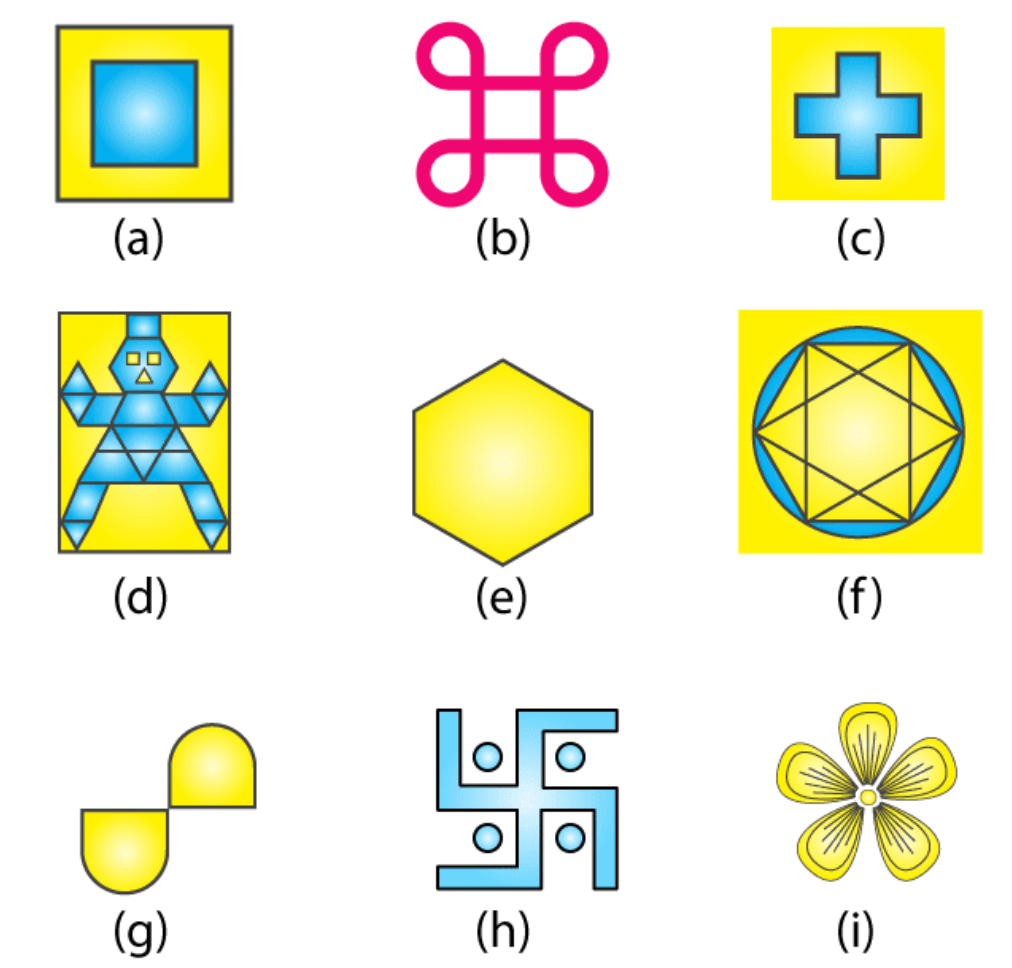 Solutions:
(a)
For the given figure, there are 4 lines of symmetry.
(b)
For the given figure, there are 4 lines of symmetry.
(c)
For the given figure, there are 4 lines of symmetry.
(d)
For the given figure, there is only 1 line of symmetry.
(e)
For the given figure, there are 6 lines of symmetry.
(f)
For the given figure, there are 6 lines of symmetry.
(g)
For the given figure, there is no line of symmetry.
(h)
For the given figure, there is no line of symmetry.
(i)
For the given figure, there are 3 lines of symmetry.
Now, we can observe the lines of symmetry in the above figures as follows:
Solutions:
(a)
For the given figure, there are 4 lines of symmetry.
(b)
For the given figure, there are 4 lines of symmetry.
(c)
For the given figure, there are 4 lines of symmetry.
(d)
For the given figure, there is only 1 line of symmetry.
(e)
For the given figure, there are 6 lines of symmetry.
(f)
For the given figure, there are 6 lines of symmetry.
(g)
For the given figure, there is no line of symmetry.
(h)
For the given figure, there is no line of symmetry.
(i)
For the given figure, there are 3 lines of symmetry.
Now, we can observe the lines of symmetry in the above figures as follows:
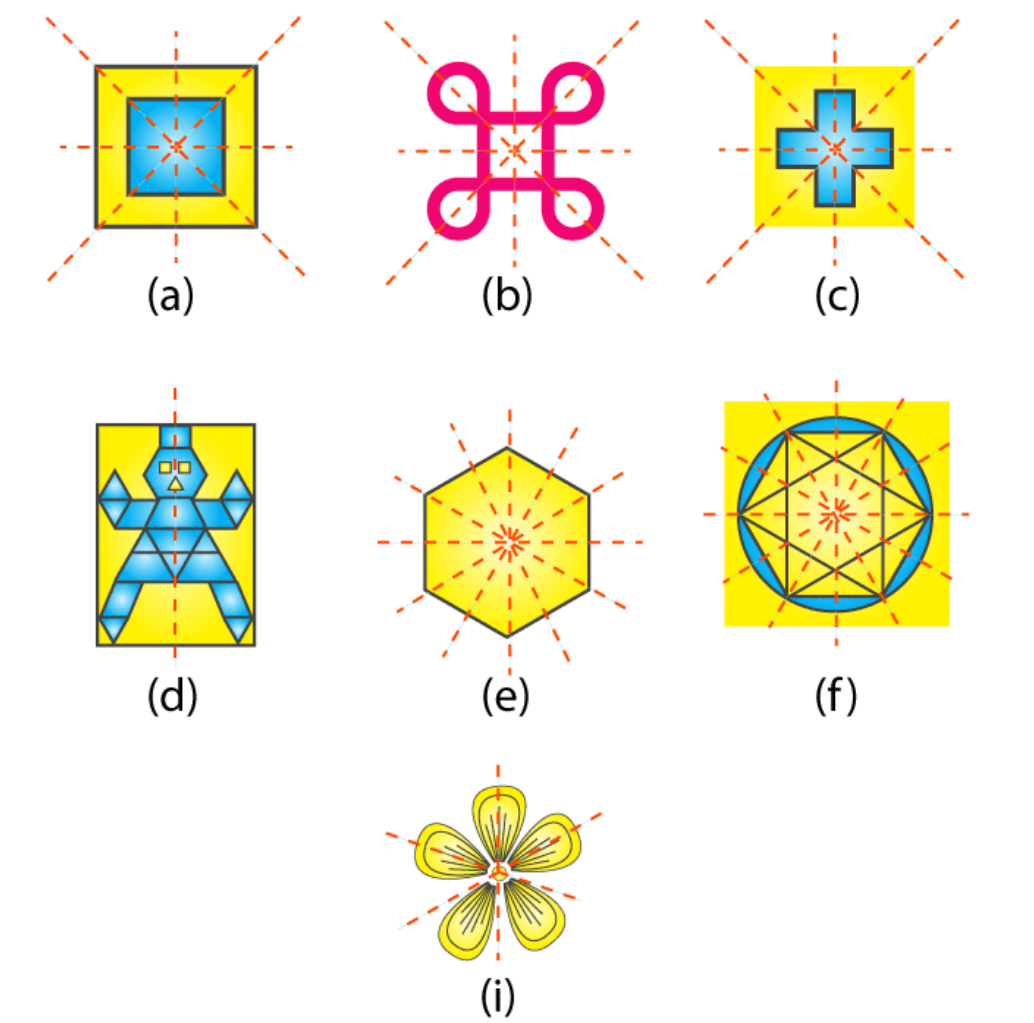
CBSE Board Exam Centre List 2024
2. Copy the triangle in each of the following figures on squared paper. In each case, draw the line(s) of symmetry, if any, and identify the type of triangle. (Some of you may like to trace the figures and try paper-folding first!)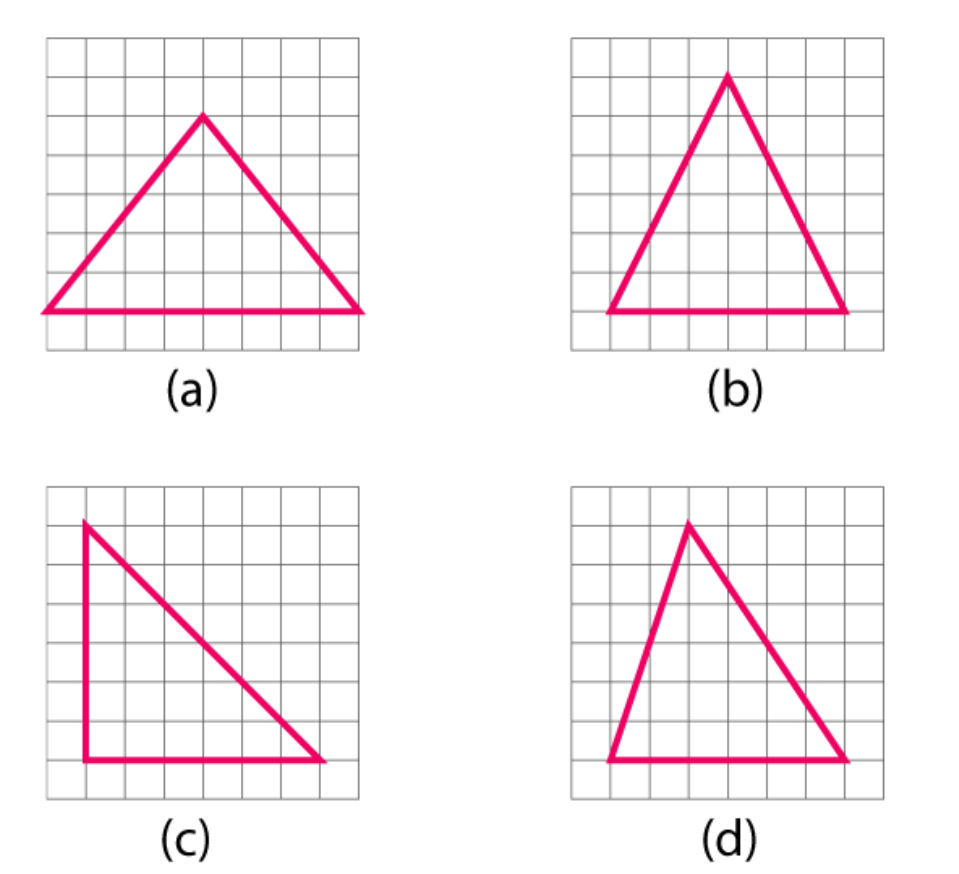 Solutions:
(a)
The given triangle is an isosceles triangle. So, there will be only 1 line of symmetry.
Solutions:
(a)
The given triangle is an isosceles triangle. So, there will be only 1 line of symmetry.
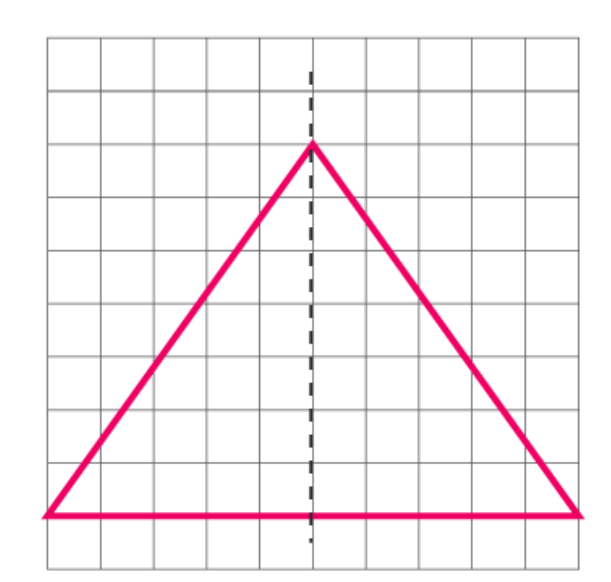 (b)
The given triangle is an isosceles triangle. So, there will be only 1 line of symmetry.
(b)
The given triangle is an isosceles triangle. So, there will be only 1 line of symmetry.
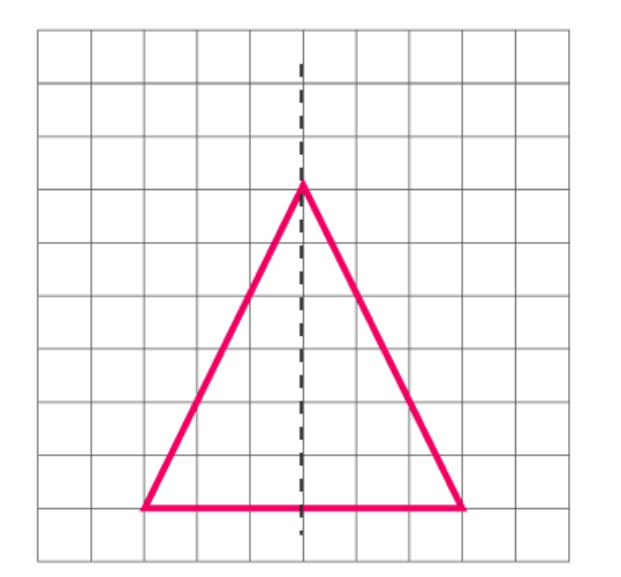 (c)
The given triangle is a right-angled triangle. So, there will be only 1 line of symmetry.
(c)
The given triangle is a right-angled triangle. So, there will be only 1 line of symmetry.
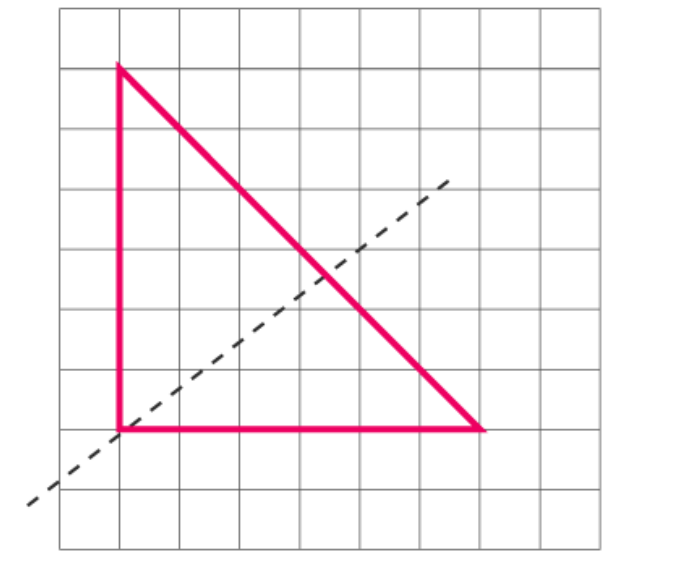 (d)
The given triangle is a scalene triangle. So, there will be no line of symmetry.
3. Complete the following table.
(d)
The given triangle is a scalene triangle. So, there will be no line of symmetry.
3. Complete the following table.
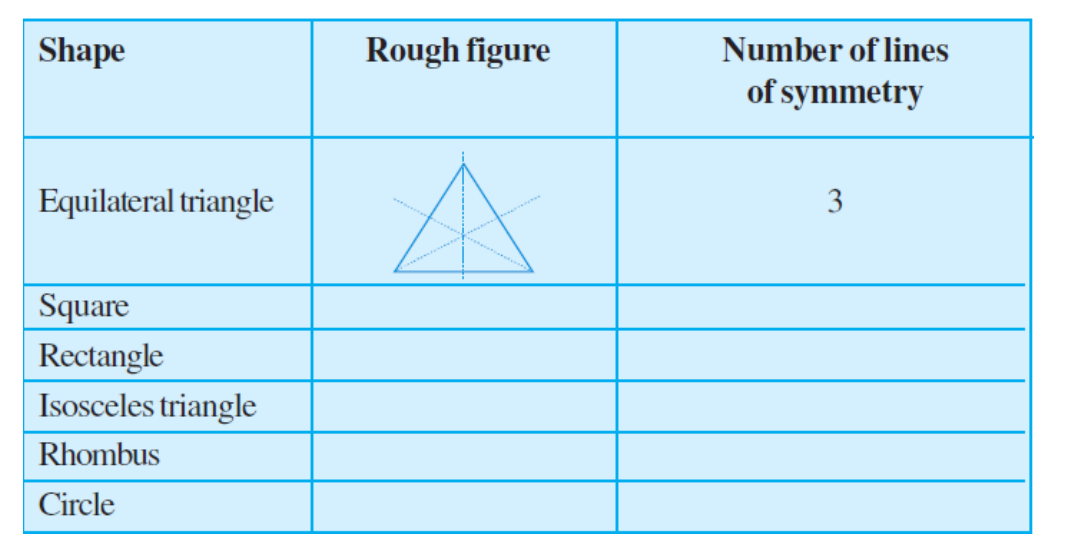 Solutions:
The given table can be completed as follows:
Solutions:
The given table can be completed as follows:
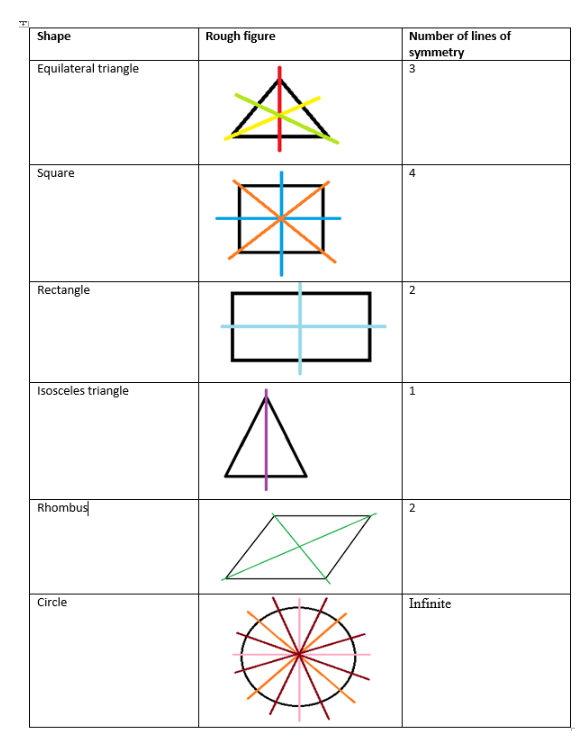 In the case of circles, we can find infinite lines. Here, some lines of symmetry are drawn. Similarly, we can draw more symmetric lines for the circle.
4. Can you draw a triangle which has
(a) exactly one line of symmetry?
(b) exactly two lines of symmetry?
(c) exactly three lines of symmetry?
(d) no lines of symmetry?
Sketch a rough figure in each case.
Solutions:
(a)
Yes, we can draw an isosceles triangle which has only 1 line of symmetry.
In the case of circles, we can find infinite lines. Here, some lines of symmetry are drawn. Similarly, we can draw more symmetric lines for the circle.
4. Can you draw a triangle which has
(a) exactly one line of symmetry?
(b) exactly two lines of symmetry?
(c) exactly three lines of symmetry?
(d) no lines of symmetry?
Sketch a rough figure in each case.
Solutions:
(a)
Yes, we can draw an isosceles triangle which has only 1 line of symmetry.
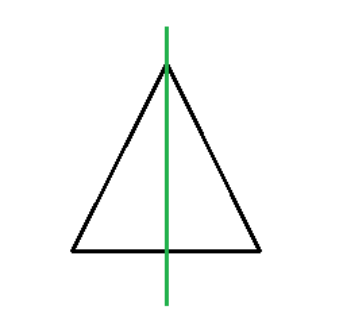 (b)
No, we cannot draw a triangle which has 2 lines of symmetry.
(c)
Yes, we can draw an equilateral triangle which has 3 lines of symmetry.
(b)
No, we cannot draw a triangle which has 2 lines of symmetry.
(c)
Yes, we can draw an equilateral triangle which has 3 lines of symmetry.
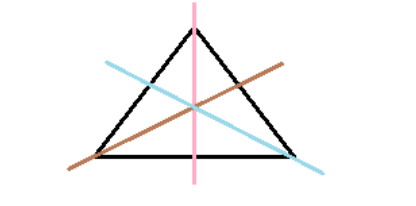 (d)
Yes, we can draw a scalene triangle which has no line of symmetry.
(d)
Yes, we can draw a scalene triangle which has no line of symmetry.
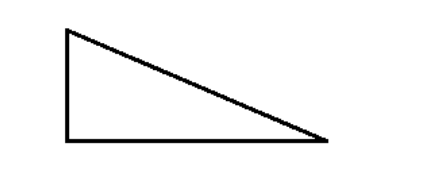 5. On a squared paper, sketch the following:
(a) A triangle with a horizontal line of symmetry but no vertical line of symmetry.
(b) A quadrilateral with both horizontal and vertical lines of symmetry.
(c) A quadrilateral with a horizontal line of symmetry but no vertical line of symmetry.
(d) A hexagon with exactly two lines of symmetry.
(e) A hexagon with six lines of symmetry.
Solutions:
(a)
A triangle with a horizontal line of symmetry but no vertical line of symmetry can be drawn as follows:
5. On a squared paper, sketch the following:
(a) A triangle with a horizontal line of symmetry but no vertical line of symmetry.
(b) A quadrilateral with both horizontal and vertical lines of symmetry.
(c) A quadrilateral with a horizontal line of symmetry but no vertical line of symmetry.
(d) A hexagon with exactly two lines of symmetry.
(e) A hexagon with six lines of symmetry.
Solutions:
(a)
A triangle with a horizontal line of symmetry but no vertical line of symmetry can be drawn as follows:
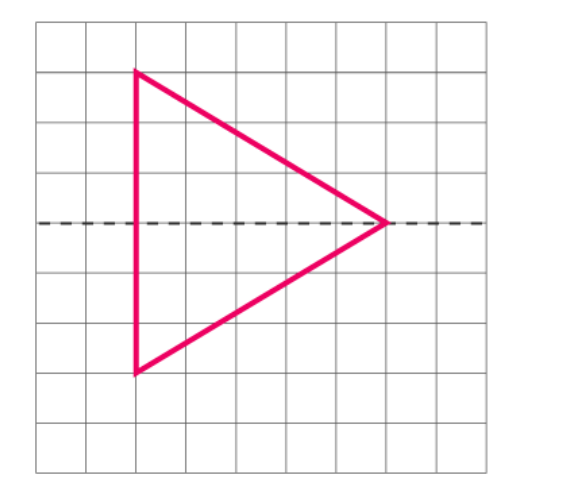 (b)
A quadrilateral with both horizontal and vertical lines of symmetry can be drawn as follows:
(b)
A quadrilateral with both horizontal and vertical lines of symmetry can be drawn as follows:
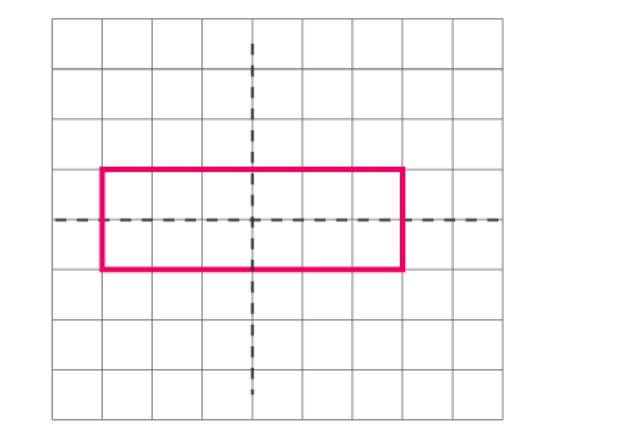 (c)
A quadrilateral with a horizontal line of symmetry but no vertical line of symmetry can be sketched as follows:
(c)
A quadrilateral with a horizontal line of symmetry but no vertical line of symmetry can be sketched as follows:
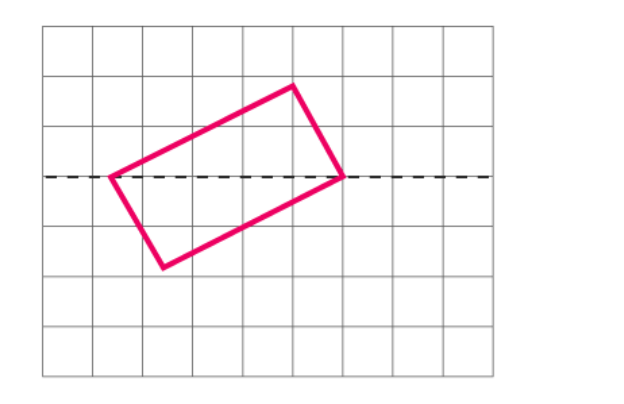 (d)
A hexagon with exactly two lines of symmetry may be drawn as follows:
(d)
A hexagon with exactly two lines of symmetry may be drawn as follows:
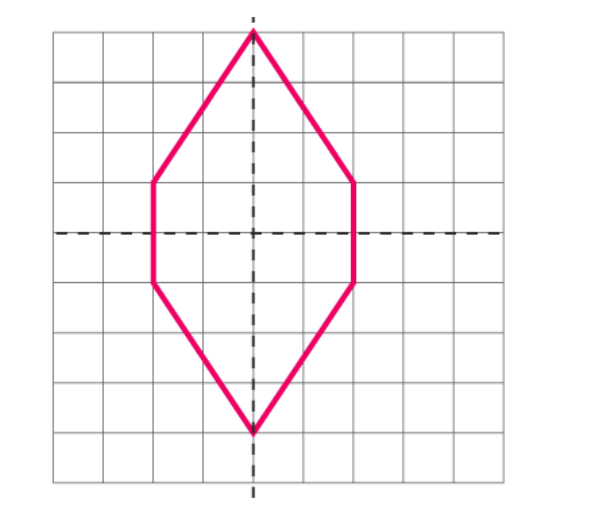 (e)
A hexagon with 6 lines of symmetry may be drawn as follows:
(e)
A hexagon with 6 lines of symmetry may be drawn as follows:
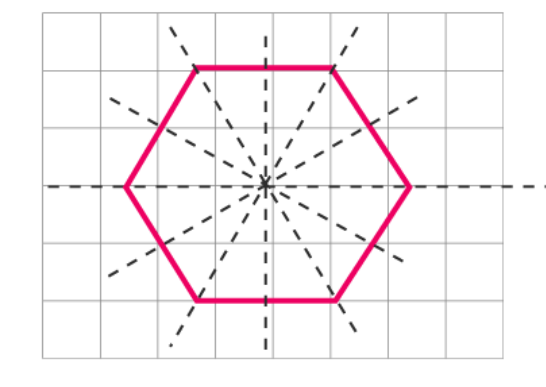
| CBSE Syllabus Class 6 | |
| CBSE Class 6 Science Syllabus | CBSE Class 6 Maths Syllabus |
| CBSE Class 6 Social Science Syllabus | CBSE Class 6 English Syllabus |
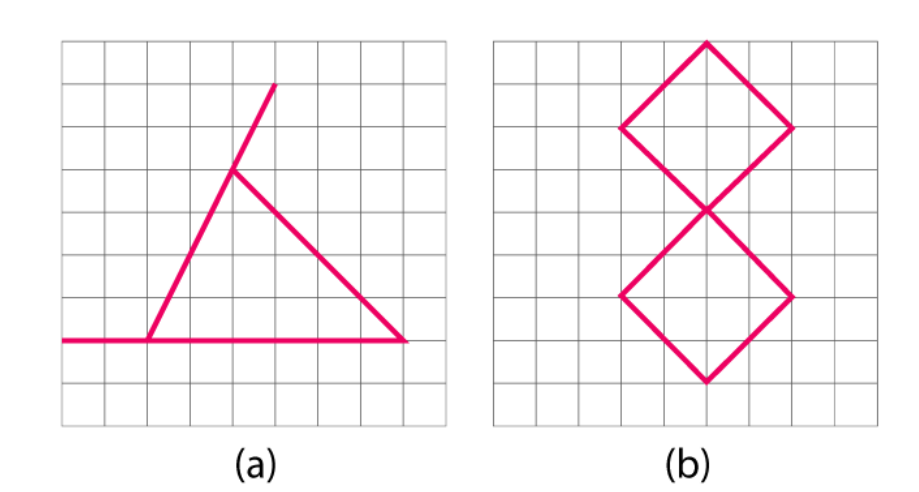
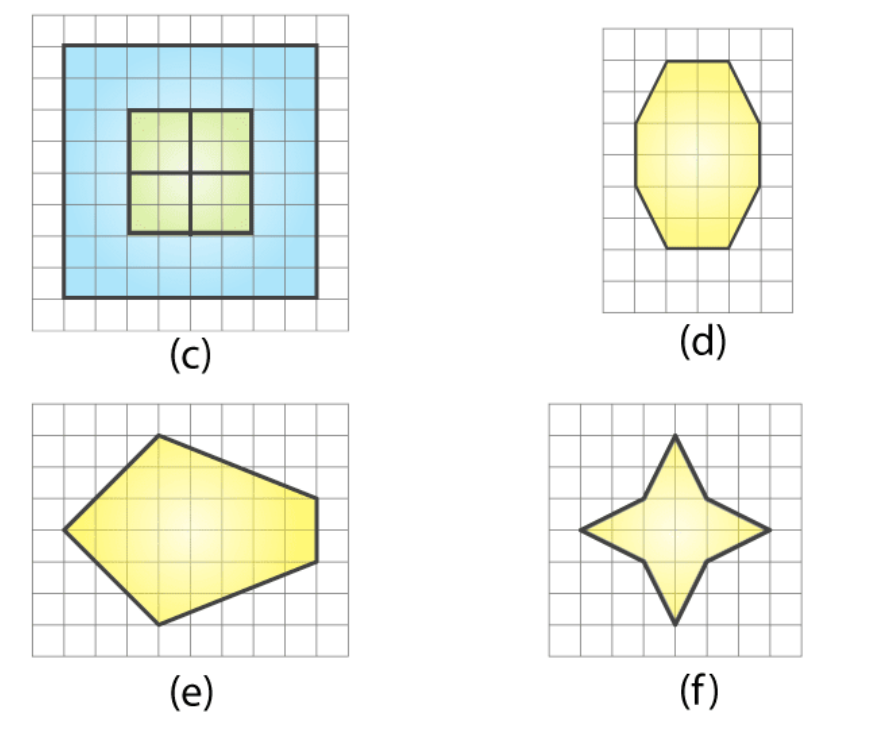 Solutions:
(a)
The given figure is an isosceles triangle. Hence, there will be 1 line of symmetry.
Solutions:
(a)
The given figure is an isosceles triangle. Hence, there will be 1 line of symmetry.
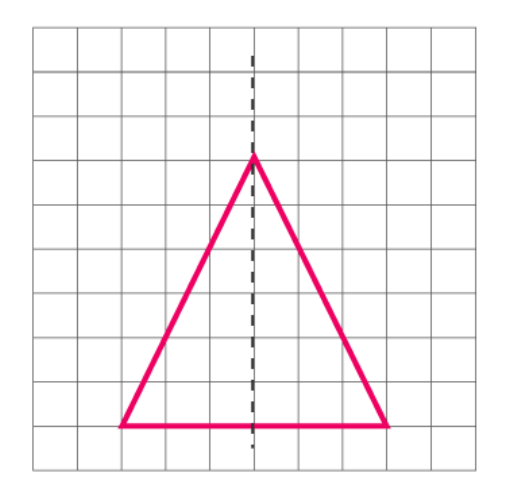 (b)
The given figure has two lines of symmetry.
(b)
The given figure has two lines of symmetry.
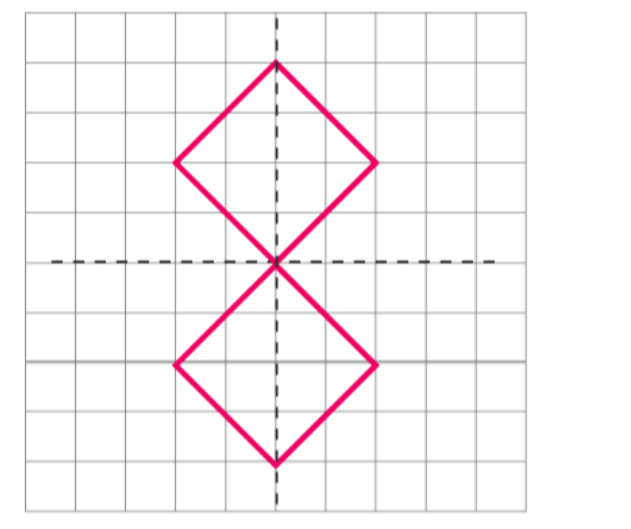 (c)
The given figure has 4 lines of symmetry.
(c)
The given figure has 4 lines of symmetry.
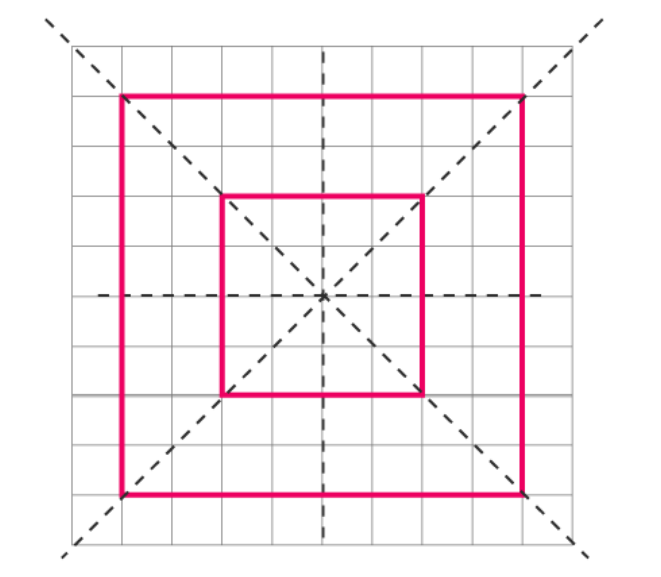 (d)
The given figure is octagonal, which has 2 lines of symmetry.
(d)
The given figure is octagonal, which has 2 lines of symmetry.
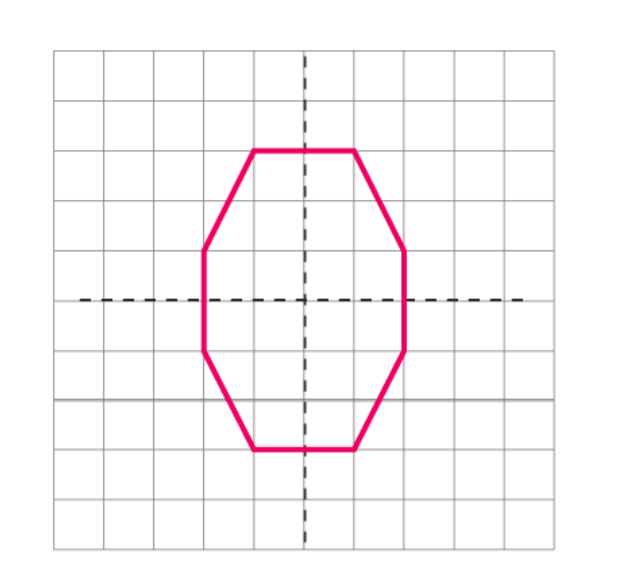 (e)
The given figure has only 1 line of symmetry.
(e)
The given figure has only 1 line of symmetry.
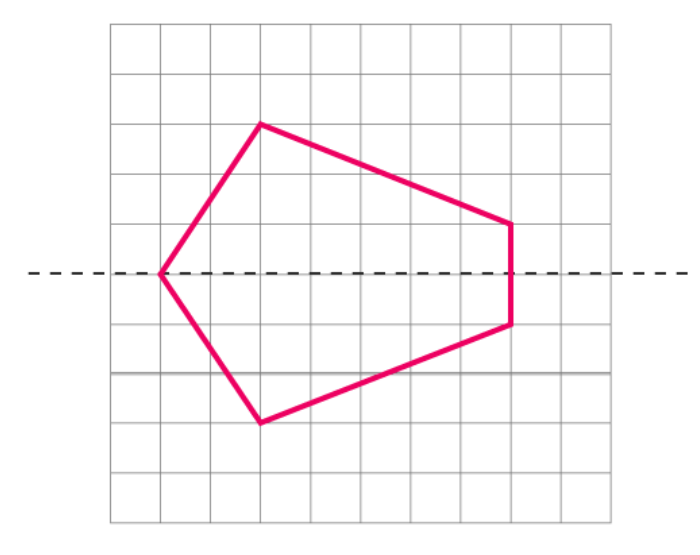 (f)
The given figure has 4 lines of symmetry.
(f)
The given figure has 4 lines of symmetry.
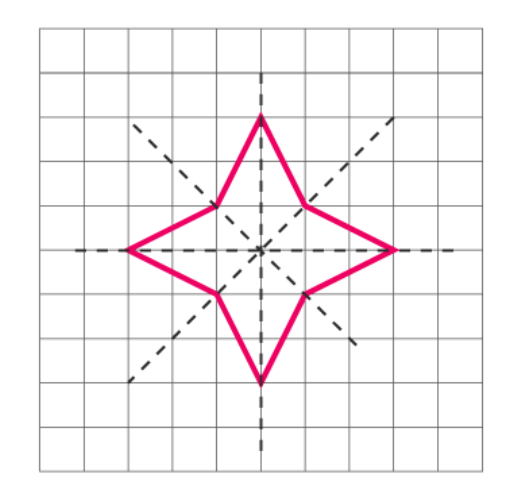 7. Consider the letters of the English alphabet, A to Z. List among them the letters which have
(a) vertical lines of symmetry (like A)
(b) horizontal lines of symmetry (like B)
(c) no lines of symmetry (like Q)
Solutions:
(a)
Vertical lines of symmetry are A, H, I, M, O, T, U, V, W, X, Y.
(b)
Horizontal lines of symmetry are B, C, D, E, H, I, K, O, X.
(c)
No lines of symmetry are F, G, J, L, N, P, Q, R, S, Z.
8. Given here are figures of a few folded sheets and designs drawn about the fold. In each case, draw a rough diagram of the complete figure that would be seen when the design is cut off.
7. Consider the letters of the English alphabet, A to Z. List among them the letters which have
(a) vertical lines of symmetry (like A)
(b) horizontal lines of symmetry (like B)
(c) no lines of symmetry (like Q)
Solutions:
(a)
Vertical lines of symmetry are A, H, I, M, O, T, U, V, W, X, Y.
(b)
Horizontal lines of symmetry are B, C, D, E, H, I, K, O, X.
(c)
No lines of symmetry are F, G, J, L, N, P, Q, R, S, Z.
8. Given here are figures of a few folded sheets and designs drawn about the fold. In each case, draw a rough diagram of the complete figure that would be seen when the design is cut off.
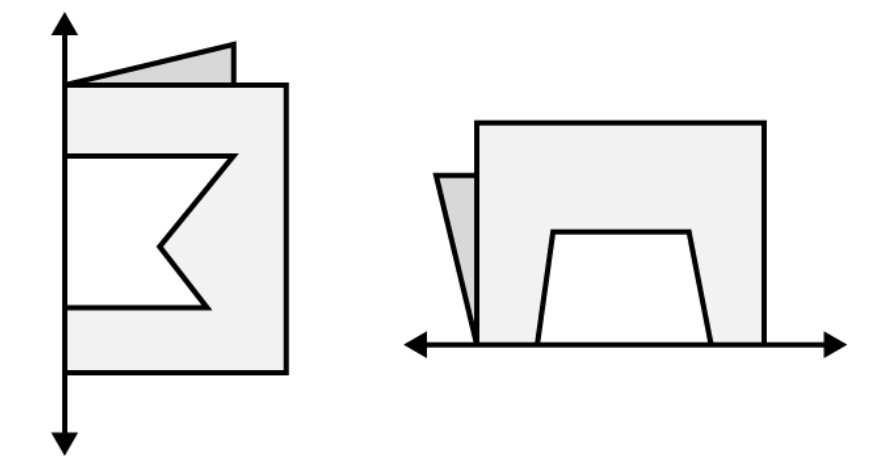 Solutions:
We can draw the diagrams of the complete figures as follows:
Solutions:
We can draw the diagrams of the complete figures as follows:
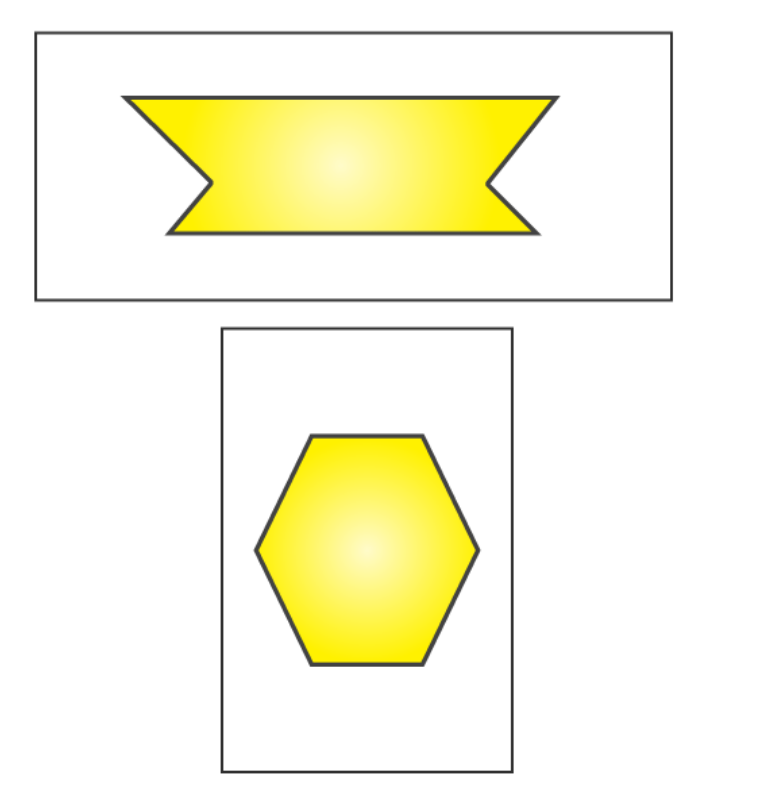 Exercise 13.3 Page No. 271
1. Find the number of lines of symmetry in each of the following shapes. How will you check your answers?
Exercise 13.3 Page No. 271
1. Find the number of lines of symmetry in each of the following shapes. How will you check your answers?
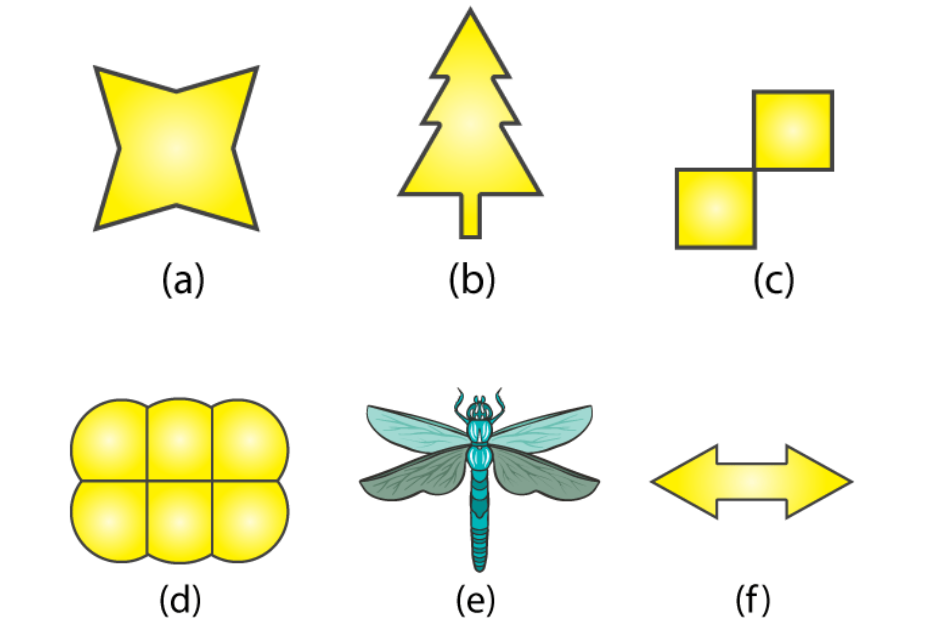 Solutions:
(a)
For the given figure, there are 4 lines of symmetry.
Solutions:
(a)
For the given figure, there are 4 lines of symmetry.
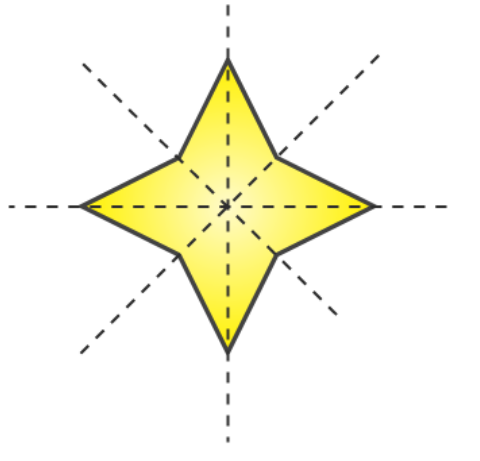 (b)
For the given figure, there is only 1 line of symmetry.
(b)
For the given figure, there is only 1 line of symmetry.
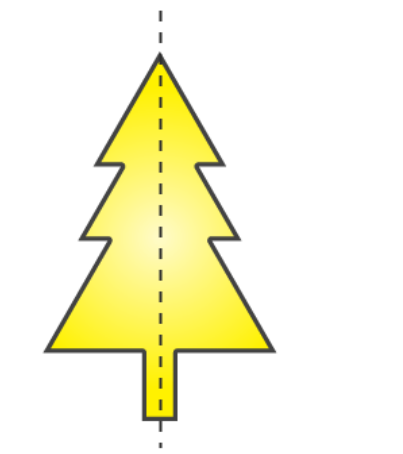 (c)
For the given figure, there are 2 lines of symmetry.
(c)
For the given figure, there are 2 lines of symmetry.
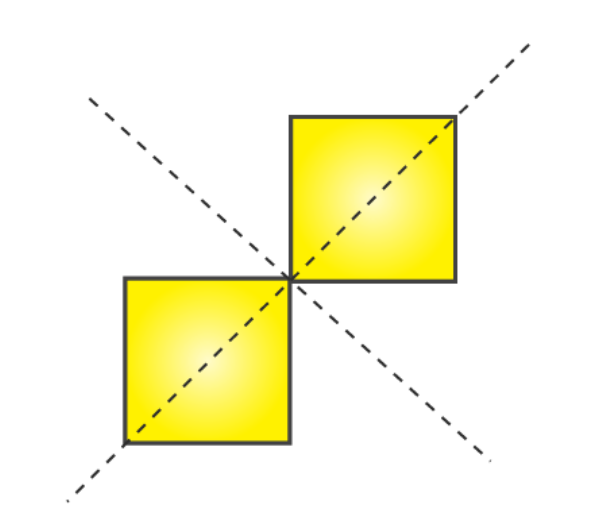 (d)
For the given figure, there are 2 lines of symmetry.
(d)
For the given figure, there are 2 lines of symmetry.
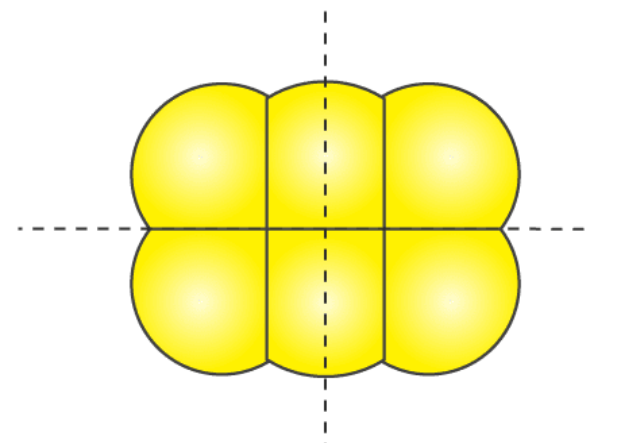 (e)
For the given figure, there is only 1 line of symmetry.
(e)
For the given figure, there is only 1 line of symmetry.
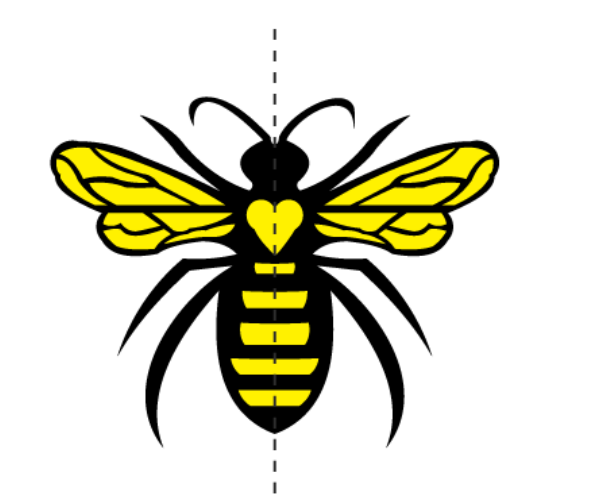 (f)
For the given figure, there are 2 lines of symmetry.
(f)
For the given figure, there are 2 lines of symmetry.
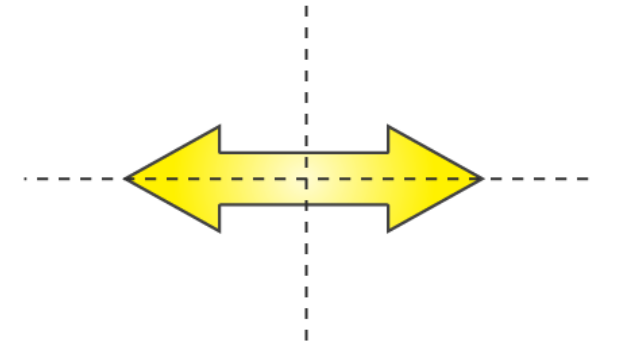 2. Copy the following drawing on squared paper. Complete each one of them such that the resulting figure has two dotted lines as two lines of symmetry.
2. Copy the following drawing on squared paper. Complete each one of them such that the resulting figure has two dotted lines as two lines of symmetry.
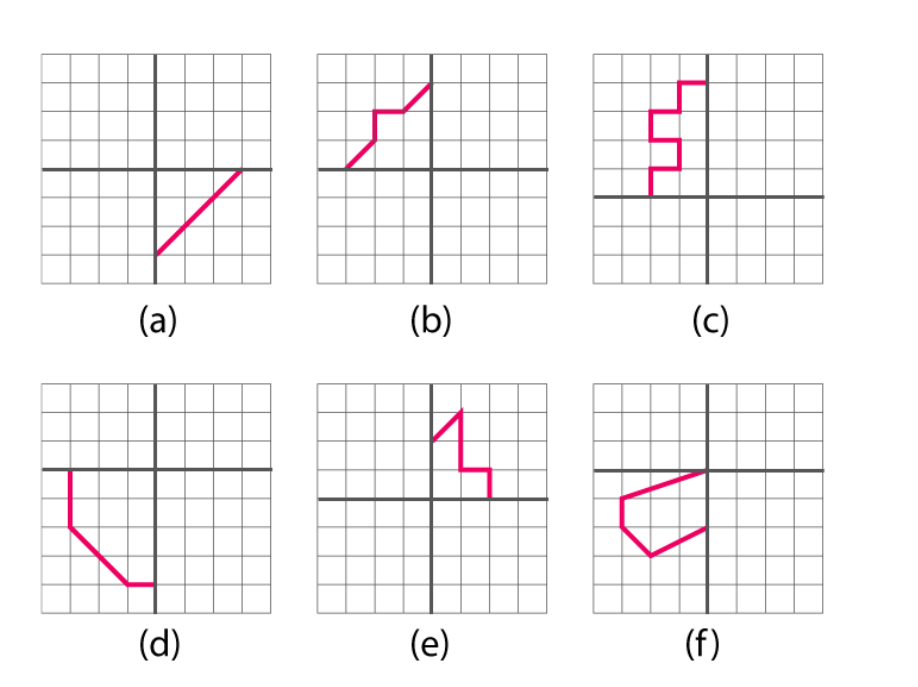 How did you go about completing the picture?
Solutions:
We can complete these figures by drawing similar parts as shown in these figures. First, about the vertical line of symmetry and then about the horizontal line of symmetry, or first about the horizontal line of symmetry and then about the vertical line of symmetry.
The completed figures are as follows:
How did you go about completing the picture?
Solutions:
We can complete these figures by drawing similar parts as shown in these figures. First, about the vertical line of symmetry and then about the horizontal line of symmetry, or first about the horizontal line of symmetry and then about the vertical line of symmetry.
The completed figures are as follows:
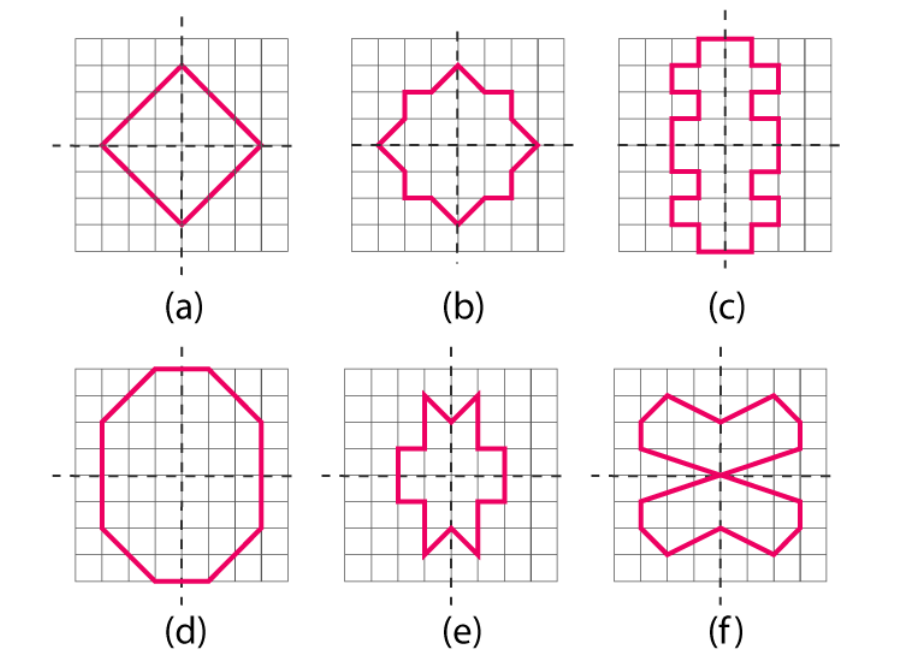 3. In each figure, a letter of the alphabet is shown along with a vertical line. Take the mirror image of the letter in the given line. Find which letters look the same after reflection (i.e., which letters look the same in the image) and which do not. Can you guess why?
Try for O E M N P H L T S V X
3. In each figure, a letter of the alphabet is shown along with a vertical line. Take the mirror image of the letter in the given line. Find which letters look the same after reflection (i.e., which letters look the same in the image) and which do not. Can you guess why?
Try for O E M N P H L T S V X
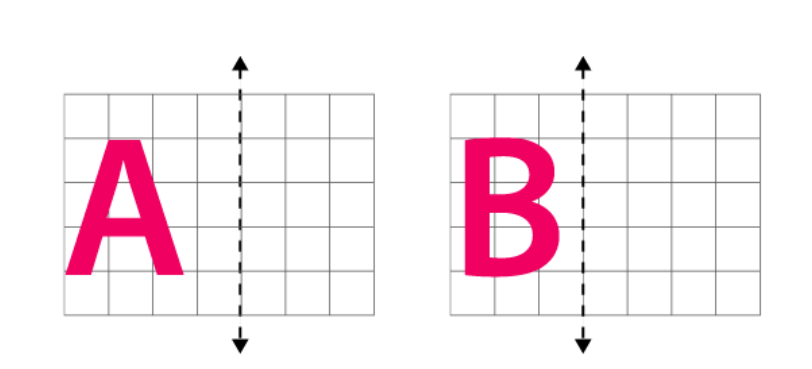 Solutions:
The mirror images of these figures are as follows
Solutions:
The mirror images of these figures are as follows
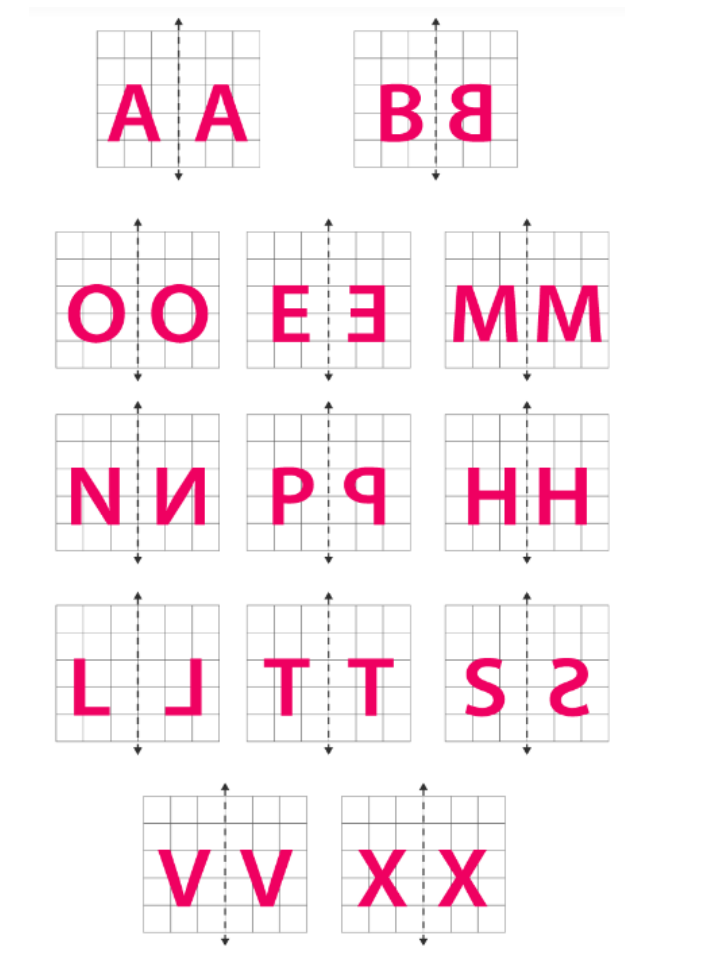 The letters having vertical lines of symmetry will have the same mirror images. These letters are O, M, H, T, V, and X, and thus these letters will look the same.
The letters having vertical lines of symmetry will have the same mirror images. These letters are O, M, H, T, V, and X, and thus these letters will look the same.
| Related Links |
NCERT Solutions for Class 6 Maths Chapter 13 Symmetry Topic-Wise Discussion
There are a total of five sections in this chapter. Here is a topic-wise brief discussion: 1. Introduction The chapter starts by giving a basic overview of Symmetry Class 6. It talks about how symmetry is present in the real world and points out examples in architectural wonders. It also explains a simple activity where you can fold a picture and use a mirror to see its symmetrical reflection. 2. Making Symmetric Figures: Ink - Blot Devils The discussion on symmetry continues in Chapter 13 of Class 6 Maths NCERT solutions. It suggests various activities for students to try at home and understand this concept better. One interesting activity involves taking a piece of paper, folding it in half, and dropping a few ink drops on one side. By pressing the paper together, students can observe the shapes formed and determine if they are symmetrical. If not, they can try folding the paper differently and repeat the experiment. Another simple experiment in Class 6 Maths Chapter 13 suggests dipping a string in paint or ink, then pressing it along the fold of a paper. Students can examine the result to check for symmetry and experiment with different paper folds to create various patterns. The section encourages students to explore symmetry in objects around them and observe the line of symmetry each object possesses. 3. Figures with Two Lines of Symmetry In this part of NCERT Class 6 Mathematics Chapter 13, students explore another idea of symmetry. Here, they learn that various shapes can have more than one line of symmetry. To make this idea simpler, students can arrange squares from their instrument box next to each other. This will form a kite shape, and they can then see how many symmetrical lines this particular figure has. Likewise, the study of symmetry in Class 6 also involves examining a rectangle. Take a piece of rectangular paper, fold it lengthwise, observe the lines, unfold it, and repeat the process widthwise. Afterward, students can check how many symmetrical lines result from this process. Class 6 Math Symmetry introduces another do-it-yourself experiment. Students can fold a piece of paper as mentioned earlier, draw a design along the folds, and then cut it out. When they unfold the paper, the design unfolds as well. They can now examine whether there is any symmetry in the design or not. The NCERT solutions for Class 6 Mathematics Chapter 13 provide accurate answers for the exercise problems. 4. Figures with Multiple (More Than Two) Lines of Symmetry This part of Symmetry for Class 6 involves talking about and trying out activities to understand objects with many symmetrical lines. There are various experiments using paper and drawing that people can do to grasp this topic better. Chapter 13 of Symmetry Class 6 also talks about how road signs come in different symmetrical shapes. Playing cards and the things around us also have objects and living beings with many symmetrical lines. 5. Reflection and Symmetry Symmetry Class 6 NCERT solutions explain how reflection and symmetry are connected. A single line, called a mirror line or line of symmetry, divides an object and its reflection. When an object shows a reflection, it stays the same in shape, size, and angles, creating perfect symmetry. To understand this idea better, students can look at their reflections in the mirror or hold an object in front of it. This helps them grasp the topic more effectively. They also learn about the uses of reflection symmetry in this NCERT solutions Class 6 Maths Chapter Symmetry.Benefits of NCERT Solutions for Class 6 Maths Chapter 13
NCERT solutions for Class 6 Maths Chapter 13 is a perfect study material to improve exam preparations for the following reasons:- CBSE Class 6 Maths Chapter 13 solutions follow the curriculum drafted by CBSE, helping students to prepare their syllabus better.
- Subject experts are in-charge of preparing these study materials; thus, they are accurate and precise.
- Also, the use of simple language helps students to comprehend the topics easily.
- The answers are comprehensive and to the point and aid students to prepare quickly.
- Additionally, the detailed explanation of every topic eliminates the need for referring to other books.
NCERT Solutions for Class 6 Maths Chapter 13 FAQs
What is symmetry according to the Class 6 Syllabus?
Symmetry, as per the Class 6 Syllabus, is defined as a balanced arrangement of elements on either side of a central point or line.
What are the types of symmetry according to the Class 6 Syllabus?
The types of symmetry in the Class 6 Syllabus include line symmetry and rotational symmetry.
How many lines of symmetry does the figure have?
The number of lines of symmetry in a figure varies, and it needs to be determined based on the specific shape or object.
What do we mean by lateral symmetry?
Lateral symmetry refers to a symmetrical arrangement where corresponding elements on the sides are identical and parallel.
How can I download the NCERT Solutions for Class 6 Maths Chapter 13?
You can download NCERT Solutions for Class 6 Maths Chapter 13 from the official NCERT website or other reputable educational platforms offering study materials.
Talk to a counsellorHave doubts? Our support team will be happy to assist you!

Free Learning Resources
PW Books
Notes (Class 10-12)
PW Study Materials
Notes (Class 6-9)
Ncert Solutions
Govt Exams
Class 6th to 12th Online Courses
Govt Job Exams Courses
UPSC Coaching
Defence Exam Coaching
Gate Exam Coaching
Other Exams
Know about Physics Wallah
Physics Wallah is an Indian edtech platform that provides accessible & comprehensive learning experiences to students from Class 6th to postgraduate level. We also provide extensive NCERT solutions, sample paper, NEET, JEE Mains, BITSAT previous year papers & more such resources to students. Physics Wallah also caters to over 3.5 million registered students and over 78 lakh+ Youtube subscribers with 4.8 rating on its app.
We Stand Out because
We provide students with intensive courses with India’s qualified & experienced faculties & mentors. PW strives to make the learning experience comprehensive and accessible for students of all sections of society. We believe in empowering every single student who couldn't dream of a good career in engineering and medical field earlier.
Our Key Focus Areas
Physics Wallah's main focus is to make the learning experience as economical as possible for all students. With our affordable courses like Lakshya, Udaan and Arjuna and many others, we have been able to provide a platform for lakhs of aspirants. From providing Chemistry, Maths, Physics formula to giving e-books of eminent authors like RD Sharma, RS Aggarwal and Lakhmir Singh, PW focuses on every single student's need for preparation.
What Makes Us Different
Physics Wallah strives to develop a comprehensive pedagogical structure for students, where they get a state-of-the-art learning experience with study material and resources. Apart from catering students preparing for JEE Mains and NEET, PW also provides study material for each state board like Uttar Pradesh, Bihar, and others
Copyright © 2025 Physicswallah Limited All rights reserved.
Get App

